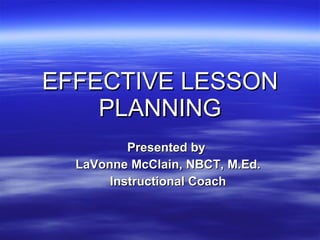Effective Lesson Planning Tips for Teachers
•
5 gefällt mir•1,316 views
The document provides guidance on effective lesson planning. It emphasizes the importance of clear objectives, engaging essential questions, appropriate assessments, and reflection. An effective lesson plan considers student needs, incorporates research-based strategies, and allows for practice, evaluation and closure. Key components include objectives, essential questions, pre-assessments, materials, engaging activities and questions, presentations, guided and independent practice, and assessments.
Melden
Teilen
Melden
Teilen

Weitere ähnliche Inhalte
Was ist angesagt?
Was ist angesagt? (20)
Andere mochten auch
Andere mochten auch (20)
Detailed Lesson Plan (ENGLISH, MATH, SCIENCE, FILIPINO)

Detailed Lesson Plan (ENGLISH, MATH, SCIENCE, FILIPINO)
Edu 645 week 3 discussion (integrating technology)

Edu 645 week 3 discussion (integrating technology)
EDUCARNIVAL 2016 at IIT DELHI - Presentation by Anuradha Mathur

EDUCARNIVAL 2016 at IIT DELHI - Presentation by Anuradha Mathur
Lesson Planning Strategies for English Language Learners K-12

Lesson Planning Strategies for English Language Learners K-12
Lesson Planning Using Universal Design for Learning

Lesson Planning Using Universal Design for Learning
EDUCARNIVAL 2016 at IIT DELHI - Presentation by Anuradha Mathur

EDUCARNIVAL 2016 at IIT DELHI - Presentation by Anuradha Mathur
Strategies for effective lesson planning flipped classroom

Strategies for effective lesson planning flipped classroom
Ähnlich wie Effective Lesson Planning Tips for Teachers
Ähnlich wie Effective Lesson Planning Tips for Teachers (20)
EFFECTIVE LESSON PLANINNG (SIGNIFICANCE AND EXECUTION).pptx

EFFECTIVE LESSON PLANINNG (SIGNIFICANCE AND EXECUTION).pptx
Mehr von LaVonne McClain, Ed.D
Mehr von LaVonne McClain, Ed.D (6)
Kürzlich hochgeladen
Kürzlich hochgeladen (20)
Call Girls in Dwarka Mor Delhi Contact Us 9654467111

Call Girls in Dwarka Mor Delhi Contact Us 9654467111
Measures of Central Tendency: Mean, Median and Mode

Measures of Central Tendency: Mean, Median and Mode
Russian Escort Service in Delhi 11k Hotel Foreigner Russian Call Girls in Delhi

Russian Escort Service in Delhi 11k Hotel Foreigner Russian Call Girls in Delhi
IGNOU MSCCFT and PGDCFT Exam Question Pattern: MCFT003 Counselling and Family...

IGNOU MSCCFT and PGDCFT Exam Question Pattern: MCFT003 Counselling and Family...
Interactive Powerpoint_How to Master effective communication

Interactive Powerpoint_How to Master effective communication
Web & Social Media Analytics Previous Year Question Paper.pdf

Web & Social Media Analytics Previous Year Question Paper.pdf
Effective Lesson Planning Tips for Teachers
- 1. EFFECTIVE LESSON PLANNING Presented by LaVonne McClain, NBCT, M.Ed. Instructional Coach
- 3. A teacher who is attempting to teach without inspiring the pupil with a desire to learn is hammering on a cold iron. Horace Mann
- 10. The greater the structure of a lesson and the more precise the directions on what is to be accomplished, the higher the achievement rate. Harry Wong, The First Days of Teaching
- 32. A teacher is one who brings us tools and enables us to use them. Jean Toomer Time to Practice!
Hinweis der Redaktion
- Effective teachers have bellringer/ opening activities Successful people prepare themselves daily for their work
- ACTIVITY: Brainstorm a list of benefits of well-planned lessons and pitfalls of poorly planned lessons Increase the amount of time a student is working and you increase learning
- Example: division problem (visual) compare divide multiply subtract compare bring down Compare this to the directions for making a model airplane (marketers have it right)
- Let the students know your objectives, why they need to know it , and how they will use the learning. Make real-world and cross-curricular connections to help students tap into prior knowledge and experiences, thus making learning easier and more relevant to the wider context. Good objective: Students will be able to illustrate clouds that signal unsettled weather. Poor objective: Students will understand that some clouds signal the approach of poor weather conditions. ACTIVITY: Have groups (2-3) write a behavioral objective for …………….
- Teachers make 1500 decisions a day… this is where it begins Previous teacher comments and test data Cum folders Classroom observation
- Integrate technology when possible. Using technology in the classroom is not only a great classroom management tool, but it also allows teachers to reach students with many different learning styles all in one tool. From interactive lessons to independent practice, this is how the current generation learns, and teachers must take advantage.
- Check for learning frequently. Whether using a simple oral question–answer session or learner response devices (ActiVote or ActivExpression), the most effective teachers check for understanding often. Doing this allows for early intervention and review or acceleration of a concept.
